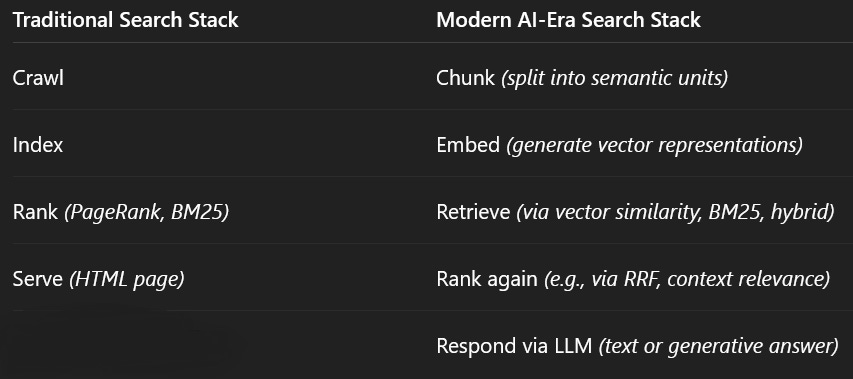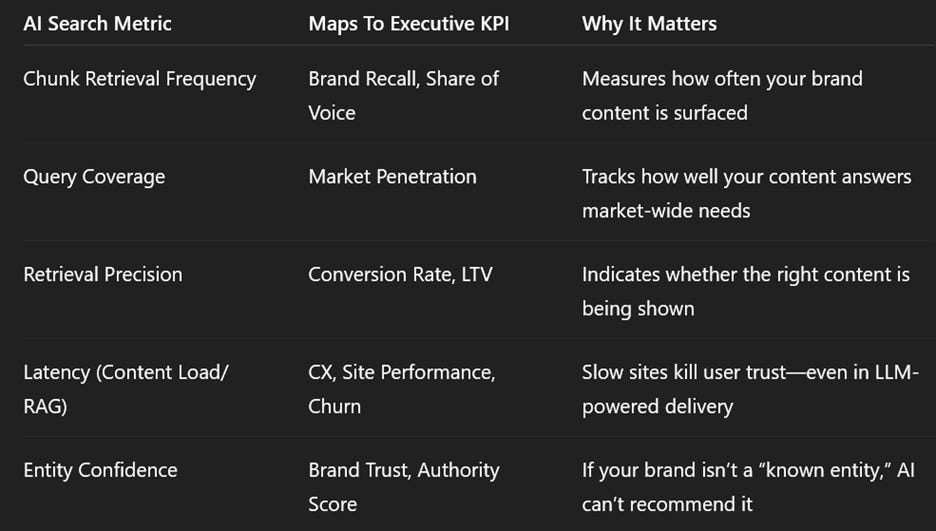Explaining AI Search to Your Execs: No, It’s Not Too Complex
If you can explain Core Web Vitals to a dev, you can explain AI search to a VP and the C-Suite.
Let’s start with the obvious: search isn’t what it used to be.
If you’re still explaining SEO in terms of keywords, crawlability, and backlinks, you’re already behind. And if your executives are still greenlighting SEO budgets based on keyword research, traffic and rankings, they’re flying blind in a fog of AI disruption.
The search stack has changed. The signals have changed. The metrics that matter? Also changed. It’s our job—not someone else’s—to translate those changes into business language the rest of the company can understand.
Here’s your framework to do exactly that.
The Search Stack Has Changed—Here’s What That Actually Means
The traditional search stack went like this:
Crawl → Index → Rank → Serve.
The new stack looks more like this:
Chunk → Embed → Store (Vector DB) → Retrieve → Rank (via RRF or other re-rankers) → Serve via LLM.
Let’s unpack that with a simple comparison table:
And if we map traditional SEO signals, we see the modern AI counterparts. Well, not exactly counterparts, but the closest approximation I can think of.
In essence, Google, ChatGPT, Perplexity, and countless enterprise tools no longer just “index” web pages. They break them into chunks—small idea-based fragments—and embed them into multi-dimensional vector space for fast retrieval.
If your content can’t be chunked, can’t be embedded well, or isn’t retrievable via RAG (retrieval-augmented generation), it may as well not exist.
Curious about how vector search powers all this? Pinecone’s breakdown of what a vector database is is a great primer. For a closer look at how retrieval and re-ranking work in tandem, check out Weaviate’s RRF explainer.
This isn’t just theory. These mechanisms are already in your life:
Google’s Gemini uses a hybrid of traditional and generative ranking.
Perplexity’s “Pro Search” ranks results using vector scoring, not just links or keywords.
OpenAI’s ChatGPT browsing with Bing retrieves pages via embedded relevance.
How ChatGPT Browsing Likely Works Today
When using the “Browse with Bing” feature, ChatGPT most likely formulates a search query based on your prompt and submits it to Bing’s search index. It then parses the top-ranked results—either via titles and snippets or by scraping full page content—and evaluates relevance using embedding similarity between your query and the retrieved content. While OpenAI hasn’t disclosed exact retrieval mechanics, it’s reasonable to assume a hybrid model: keyword-based initial retrieval via Bing, followed by vector-based re-ranking within ChatGPT to prioritize the most semantically aligned pages.
So, what does that mean for the rest of your company?
The Strategic View—How to Explain This to Executives
Your leadership team doesn’t need (or want) a lesson in embeddings or BM25. What they want to know is: why should I care?
Here’s how to bridge that gap: map the new AI-search metrics to business KPIs they already track.
These AI-search metrics can directly align with KPIs that modern executives already care about. Reframing SEO metrics in this language transforms SEO from a cost center into a strategic lever.
Executives need to see that failing to adapt doesn’t just mean losing rankings. It means becoming irrelevant in the systems powering discovery, recommendation, and decision-making.
“If your content can’t be found by a machine, it won’t be found by a human.” – often said, worth repeating.
This also opens a great conversation around marketing waste. In an AI-search world, content volume is less important than content retrievability. Publishing 50 articles that can’t be embedded or retrieved is like printing brochures and throwing them in the ocean.
Reframe the question from “how much traffic are we getting?” to “how often is our content retrieved, and by what types of systems?”
That’s a conversation worth having in the boardroom.
How to Pitch This in a Boardroom (1-Minute Version):
“AI search systems are rapidly becoming the first filter for how our customers find brands. Our goal isn’t to rank—we want to be retrievable, recommendable, and reusable by the systems people are already trusting. That requires changes across product, content, and tech. I’m here to make sure we don’t become invisible.”A Tactical Playbook—How Every Team Can Align
This is the part where most SEO strategies collapse. We diagnose technical issues, but we don’t provide downstream teams with the playbook to fix them.
Let’s work on that.
Here’s how to engage your cross-functional teams – each of these can serve as a brief. A starting point that you can build conversations and workflows around to then help each team with alignment and support:
For Content Teams
Break content into clear, standalone chunks (think H2s with self-contained ideas).
Include high-confidence entity mentions: brand names, people, products, places.
Optimize for semantic coverage, not just keyword variation.
Use structured data (schema.org) to reinforce meaning at the machine level.
Toolkits:
· XFunnel.ai entity extraction
· GPTZero’s AI detection (to avoid too much AI-written tone)
For Product & Design
Ensure site navigation and internal linking preserve semantic pathways.
This means structuring links and menus so that related concepts stay meaningfully connected—not just hierarchically, but thematically—making it easier for both users and AI systems to understand how your content fits together.
Expose product metadata in machine-readable formats (e.g. JSON-LD).
Collaborate with marketing to match taxonomy to real-world queries.
Resources:
· Google’s Structured Data documentation
· Designing AI-optimized taxonomies involves structuring content to align with semantic search and vector-based retrieval systems. This includes organizing information hierarchically, ensuring clear relationships between concepts, and facilitating machine understanding of content relevance.
Reference:
· TaxoEnrich: Self-Supervised Taxonomy Completion via Structure-Semantic Representations
https://arxiv.org/abs/2202.04887
· This paper presents a method for dynamically expanding taxonomies using self-supervised learning, which can be instrumental in maintaining and enhancing taxonomies in rapidly evolving domains.
For Marketing & Brand
Promote content in environments where AI systems listen: public forums, Q&A sites, high-authority domains.
Engineer brand mentions in narrative formats—not just backlinks.
Invest in schema-based identity building (e.g., sameAs links, logo schema, publisher fields).
Examples:
For Engineering & DevOps
Reduce page load and API response times for both users and bots.
Make sure your robots.txt and sitemap.xml are current and usable.
Monitor AI retrievability performance through custom scripts or internal crawlers designed to simulate LLM retrieval behavior. Most commercial SEO tools don't support this yet—if you want precision, you'll need to build it, unfortunately.
For AI & Data Teams
Build internal RAG prototypes using your content to test chunk success.
Compare your embeddings against competitors to identify semantic gaps.
Collaborate with marketing to define retrieval-friendly formats.
Resources:
Common Pitfalls to Avoid
You’ll get better results faster by avoiding the traps most teams fall into when reacting to these shifts:
Publishing AI-written content at scale without evaluating chunk quality or retrievability.
Assuming that structured data alone guarantees visibility—it doesn’t if retrieval systems can’t resolve context.
Using internal-only product names or jargon that doesn’t match public or search behavior.
Ignoring latency and load performance because “Google can render it eventually.”
Thinking that “indexed” still equals “visible.” It doesn’t—not in this new world.
Make this list part of your kickoff materials for every cross-functional initiative tied to content, AI, or organic visibility. It can prevent months of wasted effort.
The Wrap: Translate or Be Replaced
The future of search isn’t keywords—it’s context.
It’s not about who can publish more—it’s about who can be retrieved more.
And the job of the SEO is no longer just optimization—it’s translation.
If your leadership still views SEO as page titles, backlinks, and a monthly report on traffic, they’re not wrong—they’re just stuck in 2013. It’s on you to explain what’s really happening now.
Use this guide as your Rosetta Stone. Speak in metrics, not mysticism. Connect new signals to existing goals. And above all, make sure that in the age of AI-powered search, your brand is both findable and recommendable—to humans and machines alike.




This quite a detailed take and am definitely going to read this few more times. bookmarked.